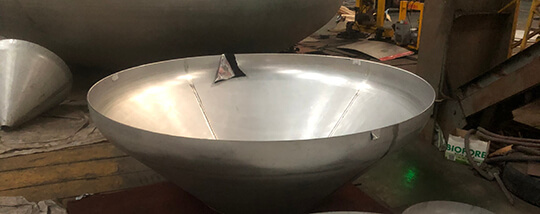1) The main cause of crack formation and propagation is thermal fatigue;
2) Part of the cracks are "hairy", conforming to the damage characteristics of thermal shock;
3) There is sulfide corrosion on the tapered head under high temperature conditions, and the corrosion of the weld surface by chloride ions, cavitation, etc., under the superimposed action of these areas and the thermal stress and high temperature gradient, new cracks and existing There is the concatenation and propagation of the crack itself.
4) The high content of Cr and Mo elements in SA387Gr11CL2 material is prone to delayed cracking; in addition, the carbonized chromium and molybdenum elements are dissolved in solid solution during welding, and the segregation of phosphorus and sulfur at the grain boundary may also lead to the occurrence of reheat cracks.
5) The combined effect of creep and thermal fatigue. The crack propagation of the tapered head is caused by the combined action of physical and chemical factors such as thermal fatigue, thermal shock, sulfide corrosion, creep, high thermal stress, and high axial stress.
Four measures to alleviate crack propagation are proposed:
1) Properly extend the coke production cycle and reduce the cycle times; control the water temperature for coke cutting and flushing, and reduce the temperature gradient.
2) Treat the reflux water used for coke cutting to reduce the content of chloride ions and reduce other forms of corrosion except sulfide.
3) Take control measures from the manufacturing stage or the repair welding stage after cracks disappear. Control the preheating temperature as follows: 150~200℃, interlayer temperature≤250℃, post heating 350℃×2h, PWHT(690±14)℃ ×2h.
4) Check the material acceptance and welding process to ensure that Cr-Mo steel can meet relevant specifications before and after welding.
The dense pitted corrosion pits on the tapered head are caused by the following factors:
1) High temperature sulfide corrosion, because the bottom of the tower contains the largest sulfur content and the highest temperature, large-area pitting corrosion is prone to occur;
2) The decoking water is recycled water, which contains relatively high chloride ions, ammonia ions and other components;
3) The outlet pressure of the decoking water for high-pressure coke cutting and cleaning is high, with an outlet pressure of 34.5MPa;
4) The corrosion area is close to the entrance of the high-temperature vacuum residue line, and the temperature of the contacting medium is high, which can reach above 500℃;
5) The sudden change of the tapered head structure will produce eddy currents during the feeding process and cause erosion or cavitation.
